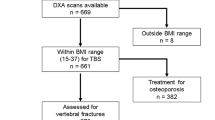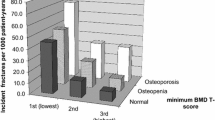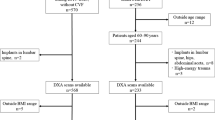Abstract
Structural failure becomes increasingly likely as the load on bone approximates or exceeds the bone’s ability to withstand it. The vertebral fracture risk index (FRI) expresses the risk for structural failure as a ratio of compressive stress (load per unit area) to estimated failure stress, and so should be a more sensitive and specific predictor of vertebral fracture than spine areal BMD (aBMD) or volumetric BMD (vBMD), surrogates of bone strength alone. To address this issue, we analyzed the results of a case-control study of 89 postmenopausal women with vertebral fractures and 306 controls in Melbourne, Australia, and a 10-year community-based prospective study in which 30 postmenopausal women who had incident vertebral fractures were compared with 150 controls in Lyon, France. The FRI and vBMD of the third lumbar vertebral body and spine aBMD were derived using dual X-ray absorptiometry. In the cross-sectional analysis, each SD increase in FRI was associated with 2.1-fold (95% confidence interval [CI], 1.55–2.73) increased vertebral fracture risk, while each SD decrease in aBMD or vBMD was associated with 4.0-fold (95% CI, 2.69–6.18 and 2.65–6.94, respectively) increase in risk. Using receiver operating characteristic (ROC) analysis, the FRI was less sensitive and specific than aBMD in discriminating cases and controls (area under ROC, 0.76 vs 0.84, p <0.01). The area under ROC curve did not differ between FRI and vBMD (0.76 vs 0.79, NS). In the prospective data set, the FRI was not predictive [hazard ratio, HR, 1.20 (95% CI, 0.9–1.7)] and was in contrast to aBMD [HR, 2.4 (95% CI, 1.5–3.8)] and vBMD [HR, 2.1 (95% CI, 1.39–3.17)]. There was also lower sensitivity using a cutoff value of FRI ≥1 compared with aBMD T -score of −2.5 SD in both studies. There was poor agreement (kappa=0.13–0.18) between FRI and aBMD T -scores in detecting fractures; each method only identified around 50% of fractured cases. Within the constraints of the sample size, we concluded that applying a biomechanical index such as FRI at the spine is no better in discriminating fracture cases and controls than conventional aBMD or vBMD. The FRI may not predict incident vertebral fractures.



Similar content being viewed by others
References
Stone KL, Seeley DG, Lui L-Y, Cauley JA, Ensrud K, Browner WS, Nevitt MC, Cummings SR, for the study of Osteoporotic Fracture Research Group (2003) BMD at multiple sites and risk of fracture of multiple types: long-term results from the study of osteoporotic fractures. J Bone Miner Res 18:1947–1954
Hui SL, Slemenda CW, Johnston CCJ (1988) Age and bone mass as predictors of fracture in a prospective study. J Clin Invest 81:1804–1809
Kanis JA, Gluer CC (2000) An update on the diagnosis and assessment of osteoporosis with densitometry. Osteoporos Int 11:192–202
Orwoll E (2000) Assessing bone density in men. J Bone Miner Res 15:1867–1870
Delmas PD (2000) Do we need to change the WHO definition of osteoporosis? Osteoporos Int 11:189–191
Faulkner KG, von Stetten E, Miller P (1999) Discordance in patients classification using T-scores. J Clin Densitom 2:343–350
Ahmed AIH, Blake GM, Rymer JM, Fogelman I (1997) Screening for osteopenia and osteoporosis: do the accepted normal ranges lead to overdiagnosis? Osteoporos Int 7:432–438
O’Gradaigh D, Debiram I, Love S, Richards HK, Compston JE (2003) A prospective study of discordance in diagnosis of osteoporosis using spine and proximal femur bone densitometry. Osteoporos Int 14:13–18
Sanders KM, Seeman E, Henry M, Kotowicz MA, Pasco JA, Nicholson GC (2002) ‘WHO’ guidelines are insensitive: Geelong Osteoporosis Study. Proceedings of Australia and New Zealand Bone Mineral Society, Adelaide, Australia, Abstract O15
Schuit SCE, van der Klift M, Weel AEAM, de Laet CEDH, Burger H, Seeman E, Hofman A, Uitterlinden AG, van Leeuwen JPTM, Pols HAP (2003) Fracture incidence and association with bone mineral density in elderly men and women: the Rotterdam study. Bone 34:195–202
Seeman E (2001) Sexual dimorphism in skeletal size, density and strength. J Clin Endocrinol Metab 86:4576–4584
Duan Y, Seeman E, Turner CH (2001) The biomechanical basis of vertebral body fragility in men and women. J Bone Miner Res 16:2276–2283
Peacock M, Turner CH, Liu G, Manatunga AK, Timmerman L, Johnston CC Jr (1995) Better discrimination of hip fracture using bone density, geometry and architecture. Osteoporos Int 5:167–173
Myers ER, Wilson SE (1997) Biomechanics of osteoporosis and vertebral fracture. Spine 22:25S–31S
Bouxsein ML (2001) Biomechanics of age-related fractures. In: Marcus R, Feldman D, Kelsey J (eds) Osteoporosis, 2nd edn. Academic Press, San Diego, CA, USA, pp 509–531
Turner CH (1996) Letter to the editor. Bone 19:73–74
Arlot ME, Sornay-Rendu E, Garnero P, Vey-Marty B, Delmas PD (1997) Apparent pre- and postmenopausal bone loss evaluated by DXA at different skeletal sites in women: the OFELY cohort. J Bone Miner Res 12:683–690
Genant HK, Jergas M, Palermo L, Nevitt M, Valentin RS, Black D, Cummings SR, for the Study of Osteoporotic Fractures Research Group (1996) Comparison of semiquantitative visual and quantitative morphometric assessment of prevalent and incident vertebral fractures in osteoporosis. J Bone Miner Res 11:984–996
Duan Y, Turner CH, Kim BT, Seeman E (2001) Sexual dimorphism in vertebral fragility is more the result of gender differences in bone gain than bone loss. J Bone Miner Res 16:2267–2275
Duboeuf F, Pommet R, Meunier PJ, Delmas PD (1994) Dual-energy X-ray absorptiometry of the spine in anteroposterior and lateral projections. Osteoporos Int 4:110–116
Kelsey JL, Sowers MF (2001). Introduction to epidemiologic methods. In: Marcus R, Feldman D, Kelsey J (eds) Osteoporosis, 2nd edn. Academic Press, San Diego, CA, USA, pp 535–555
Yoskikawa T, Turner CH, Peacock M, Slemenda CW, Weaver CM, Teegarden D, Markwardt P, Burr DB (1994) Geometric structure of the femoral neck measured using dual-energy X-ray absorptiometry. J Bone Miner Res 9:1053–1064
Myers ER, Robinovitch SN, Greenspan SL, Hayes WC (1994) Factor of risk is associated with frequency of hip fracture in a case control study. Trans Orthop Res Soc 19:526
Hillier TA, Beck TJ, Oreskovic T, Rizzo JH, Pedula KL, Black D, Stone KL, Cauley JA, Bauer DC, Taylor BC, Cummings SR (2003) Predicting long-term hip fracture risk with bone mineral density and hip structure in postmenopausal women: The study of osteoporotic fracture. J Bone Miner Res 18 [Suppl 2]:S20 (Abstract)
Duboeuf F, Szulc P, Schott AM, Meunier P, Delmas PD (2003) Parameters of hip geometry and bone mineral density measured by dual energy X-ray absorptiometry as predictors of hip fracture risk in elderly women from EPIDOS cohort. J Bone Miner Res 18 [Suppl. 2]:S64 (Abstract)
Burr DB, Forwood MR, Fyhrie DP, Martin RB, Schaffler MB, Turner CH (1997) Bone microdamage and skeletal fragility in osteoporotic and stress fractures. J Bone Miner Res 12:6–15
Recker RR, Barger-Lux MJ (2001) Bone remodeling findings in osteoporosis. In: Marcus R, Feldman D, Kelsey J (eds) (2001) Osteoporosis, 2nd edn, vol 2. Academic Press, San Diego, CA, USA, pp 59–70
Cummings SR, Marcus R, Palermo L, Ensrud KE, Genanat HK, and the Study of Osteoporotic Fracture Research Group (1994) Does estimating volumetric bone density of the femoral neck improve the prediction of hip fracture? A prospective study. J Bone Miner Res 9:1429–1432
Peel NFA, Eastell R (1994) Diagnostic value of estimated volumetric bone mineral density of the lumbar spine in osteoporosis. J Bone Miner Res 9:317–320
Tabensky AD, Williams J, Deluca V, Brigant E, Seeman E (1996) Bone mass, areal and volumetric bone density are equally accurate, sensitive, and specific surrogates of the breaking strength of the vertebral body: an in vitro study. J Bone Miner Res 11:1981–1988
Melton LJ 3rd, Atkinson EJ, O’Connor MK, O’Fallon WM, Riggs BL (1998) Bone density and fracture risk in men. J Bone Miner Res 13:1915–1923
Siris ES, Chen YT, Abbott TA, Barrett-Connor E, Miller PD, Wehren LE, Berger ML (2004) Bone mineral density thresholds for pharmacological intervention to prevent fractures. Arch Intern Med 164:1108–1112
Gilsanz V, Loro ML, Roe TF, Sayre J, Gilsanz R, Schulz EE (1995) Vertebral size in elderly women with osteoporosis: Mechanical implication and relationship to fractures. J Clin Invest 95:2332–2337
Kumar S (1988) Moment arms of spinal musculature determined from CT scans. Clin Biomech 3:137–144
Acknowledgments
We thank Research Nurse Jan Edmonds, Dr. Xiao-Fang Wang, the senior technologists, Alison Evans, Helen Patterson, and Patricia D’Souza for their assistance with subject recruitment and technical assistance during this study. We also thank Dr. Charles Turner for helping us to address the reviewer’s comments and the original contribution he made. This work was supported partly by a grant from Australia National Health and Medical Research Council (E.S., grant no. 145820 & 209014)
Author information
Authors and Affiliations
Corresponding author
Rights and permissions
About this article
Cite this article
Duan, Y., Duboeuf, F., Munoz, F. et al. The fracture risk index and bone mineral density as predictors of vertebral structural failure. Osteoporos Int 17, 54–60 (2006). https://doi.org/10.1007/s00198-005-1893-5
Received:
Accepted:
Published:
Issue Date:
DOI: https://doi.org/10.1007/s00198-005-1893-5




